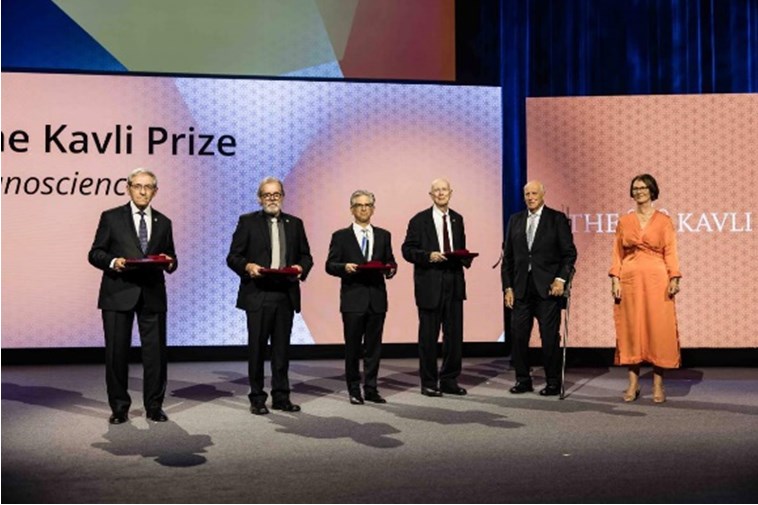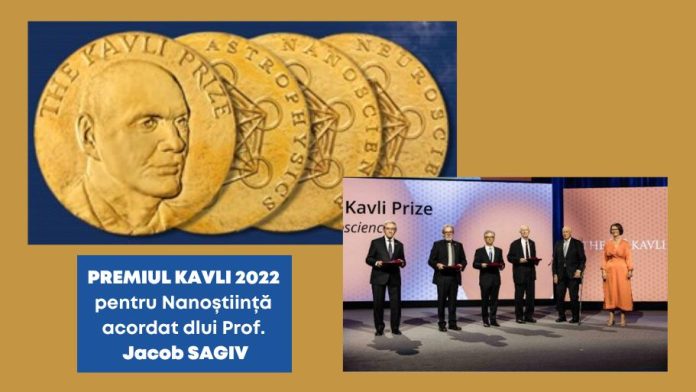In a festive ceremony on 6 September 2022 at the Oslo Concert Hall, Prof. Jacob Sagiv of the Weizmann Institute of Science, Israel, an honorary member of the AOȘR, received the Kavli 2022 Prize for Nanoscience. You can watch the ceremony on the AOSR You Tube channel at https://www.youtube.com/watch?v=I8b7yyJ28iE&list=PLJpvLc37UAv51J-45buIrz5by5CxdGAEu&index=2
Prof. Jacob Sagiv, a member of the Department of Molecular Chemistry and Materials Science at the Weizmann Institute of Science, was honoured – along with three other laureates – for pioneering research in the field of “Self-assembled monolayers on solid substrates: molecular coatings for controlling surface properties”.

Prof. Jacob Sagiv (left) receives the Kavli Prize from King Harald V of Norway (second from right) and Prof. Lise Øvreås, President of the Norwegian Academy of Sciences and Letters.
According to the Kavli Foundation’s official website, the Kavli Prize, awarded every two years, “honours scientists for discoveries in the fields of astrophysics, nanoscience and neuroscience – the big, the small and the complex”. The laureates, who share $1 million in each of three scientific fields, are selected by committees appointed by the Norwegian Academy of Sciences and Letters. Prof. Sagiv shares the award with David L. Allara of Pennsylvania State University, Ralph G. Nuzzo of the University of Illinois at Urbana-Champaign and George Whitesides of Harvard University.
Between 1978 and 1980, Jacob Sagiv, a chemist and researcher in materials physics and chemistry, published pioneering scientific papers in what was to become the modern field of self-assembled monolayer research.
A relevant web page http://www.ishitech.co.il/0202ar3.htm is dedicated to the prestigious achievements in nanoscience and nanotechnology of Prof. Jacob Sagiv.
In 1980, Jacob Sagiv discovered that molecules containing a chemical called octadecyltrichlorosilane (OTS) spontaneously react with a glass surface to assemble themselves into individual layers [1]. In 1983, a Bell Labs research team led by David Allara discovered that molecules with thiol (sulfur-containing) groups on a gold surface also self-assemble into individual layers [2]. These self-assembled monolayers are a few nanometres thick (determined by the choice of molecule) and allow researchers to tailor the properties of a surface. For the first time, scientists could imagine building three-dimensional structures at the nanoscale layer by layer, such as laying rows of bricks to build a wall. These structures are used to build molecule-based electronic devices, biosensors and new types of optical materials.
[1] J. Sagiv, J. Am. Chem. Shock. 102, 92-98 (1980).
[2] R. G. Nuzzo, D. L. Allara, J. Am. Chem. Shock. 105, 4481-4483 (1983).
The Google Academic database shows that Jacob Sagiv’s pioneering paper, published in 1980 in the Journal of the American Chemical Society, is cited more than 2300 times (Google Academic, November 2022).
Jacob Sagiv has published over 70 scientific papers in high impact journals (three papers in Nature, several papers in Advanced Materials, Nano Letters, Langmuir, etc.), which have been cited more than 7500 times (excluding self-citations). The average number of citations for each paper exceeds 100, a high score, indicating a very influential, world-class scientist, a possible future Nobel Prize winner.
His seminal achievement, published in 1980 in J. Am. Chem. Soc., is mentioned in the list of the most prominent nanoscience discoveries of the 20th century; see web page: https://www.iinano.org/from-1971-to-2000/


